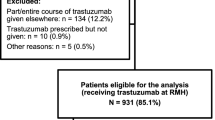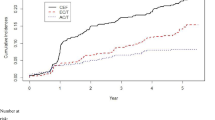Abstract
Background Cardiac toxicity from anthracyclines (ACH) can lead to therapy discontinuation, hospitalization or congestive heart failure (CHF). Since such risk may vary by patient, we developed and tested a risk-prediction tool for cardiac toxicity in metastatic breast cancer (MBC) patients receiving chemotherapy with doxorubicin, either in its traditional (DOX) or pegylated liposomal (PLD) formulation. Methods Data was obtained (n = 509) from a randomized clinical trial of MBC patients assigned either DOX (60 mg/m2 every 3 weeks) or PLD (50 mg/m2 every 4 weeks) (O’Brien Ann Oncol 15, 440–449, 2004). Patient, disease and treatment factors were identified for each cycle of therapy. Factors with a P-value of ≤0.25 with ≥grade 2 cardiac toxicity following a cycle were retained and included in a generalized estimating equations (GEE) regression model A risk scoring algorithm (range 0–62) was then developed from the final model. Results Factors predictive of cardiac toxicity included an interaction effect between DOX and the number of cumulative cycles, patient age and weight, previous ACH exposure and poor performance status. A ROC analysis had an area under the curve (AUC) of 0.84 (95% CI: 0.79–0.89). A precycle risk score cutoff of ≥30 to <40 was identified to optimally balance sensitivity (58.5%) and specificity (89.0%). Patients with a score in a given cycle, within or above this threshold, would be considered at high risk for cardiac toxicity. Conclusion Our model provides patient specific risk information that could be helpful in assessing the risks and benefits of anthracyclines in the MBC patients.


Similar content being viewed by others
References
Bonadonna G, Brusamolino E, Valagussa P et al (1976) Combination chemotherapy as an adjuvant treatment in operable breast cancer. N Engl J Med 294:405–410
Levine MN Trudeau M, Charbonneau F et al (2005) Selection of adjuvant chemotherapy for treatment of node-positive breast cancer. Lancet Oncol 6:886–898
Bergh J, Jonsson PE, Glimelius B et al (2001) A systematic overview of chemotherapy effects in breast cancer. Acta Oncol 40:253–281
Chan S, Friedrichs K, Noel D et al (1999) Prospective randomized trial of docetaxel versus doxorubicin in patients with metastatic breast cancer. J Clin Oncol 17:2341–2354
Paridaens R, Biganzoli L, Bruning P et al (2000) Paclitaxel versus doxorubicin as first-line single-agent chemotherapy for metastatic breast cancer: A European Organization for Research and Treatment of Cancer Randomized Study with cross-over. J Clin Oncol 18:724–733
Sledge GW, Neuberg D, Bernardo P et al (2003) Phase III trial of doxuribicin, paclitaxel and the combination of doxorubicin and paclitaxel as front-line chemotherapy for metastatic breast cancer. J Clin Oncol 21:588–592
Pritchard KI, Shepherd LE, O’Malley FP et al (2006) HER2 and responsiveness of breast cancer to adjuvant chemotherapy. N Engl J Med 354:2103–2111
Jensen BV (2006) Cardiotoxic consequences of anthracycline-containing therapy in patients with breast cancer. Semin Oncol 33(3 Suppl 8):S15–S21
Jackson JA, Reeves JP, Muntz KH et al (1984) Evaluation of free radical effects and catecholamine alterations in adriamycin cardiotoxicity. Am J Pathol 117:140–153
Myers CE, McGuire WP, Liss RH et al (1977) Adriamycin: the role of lipid peroxidation in cardiac toxicity and tumour response. Science 197:165–167
Singal PK, Iliskovic N (1998) Doxorubicin induced cardiomyopathy. N Engl J Med 339:900–905
Elliott P (2006) Pathogenesis of cardiotoxicity induced by anthracyclines. Semin Oncol 33(3 Suppl 8):S2–S7
O’Brien ME, Wigler N, Inbar M et al (2004) Reduced cardiotoxicity and comparable efficacy in a phase III trial of pegylated liposomal doxorubicin HCl (CAELYX/Doxil) versus conventional doxorubicin for first-line treatment of metastatic breast cancer. Ann Oncol 15:440–449
Pai VB, Nahata MC (2000) Cardiotoxicity of chemotherapeutic agents: incidence, treatment and prevention. Drug Saf 22:263–302
George SL (1988) Identification and assessment of prognostic factors. Semin Oncol 15:462–471
Allison PD (1999) Logistic regression using the SAS system: theory and application, Chapter 8. SAS Institute Inc., Cary, NC, pp 179–216
Steyerberg EW, Eijkemans MJ, Harrell FE Jr et al (2001) Prognostic modeling with logistic regression analysis: in search of sensible strategies in small data sets. Med Decis Making 21:45–56
Steyerberg EW, Harrell FE Jr, Borsboom GJ et al (2001) Internal validation of predictive models: efficiency of some procedures for logistic regression analysis. J Clin Epidemiol 54:774–781
Hanley JA, McNeil BJ (1982) The meaning and use of the area under a receiver operating characteristic (ROC) curve. Radiology 143:29–36
McNeil BJ, Hanley JA (1984) Statistical approaches to the analysis of receiver operating characteristic (ROC) curves. Med Decis Making 4:137–150
Doyle JJ, Neugut AI, Jacobson JS et al (2005) Chemotherapy and cardiotoxicity in older cancer patients. A population-based study. J Clin Oncol 23:8597–8605
Wojtacki J, Lewicka-Nowak E, Lesniewski-Kmak K (2000) Anthracycline induced cardiotoxicity: clinical course, risk factors, pathogenesis, detection and prevention. A review of the literature. Med Sci Monit 6:411–420
Wong CY, O’Moore-Sullivan T, Leano R et al (2004) Alterations of left ventricular myocardial characteristics associated with obesity. Circulation 110:3081–3087
Di Bello V, Santini F, Di Cori A et al (2006) Obesity cardiomyopathy: is it a reality? An ultrasonic tissue characterization study. J Am Soc Echocardiogr 19:1063–1071
Sabel MS, Levine EG, Hurd T et al (2001) Is MUGA scan necessary in patients with low-risk breast cancer before doxorubicin-based adjuvant therapy?. Am J Clin Oncol 24:425–428
Jensem BV, Skovsgaard T, Nielsen SL (2002) Functional monitoring or anthracycline cardiotoxicity: a prospective, blinded, long term observational study of outcome in 120 patients. Ann Oncol 13:699–709
Katz MH (2003) Multivariable analysis: a primer for readers of the medical literature. Ann Intern Med 138:644–650
Perez EA, Suman VJ, Davidson NE et al (2004) Effect of doxorubicin plus cyclophospamide on left ventricular ejection fraction in patients with breast cancer in the North Central Cancer Treatment Group N9831 Intergroup Adjuvant trial. J Clin Oncol 22:3700–3704
Achnowledgements
We are grateful to Schering-Plough Corp who provided financial support to conduct this study and for access to the clinical trial database that was the starting point for the analysis.
Author information
Authors and Affiliations
Corresponding author
Rights and permissions
About this article
Cite this article
Dranitsaris, G., Rayson, D., Vincent, M. et al. The development of a predictive model to estimate cardiotoxic risk for patients with metastatic breast cancer receiving anthracyclines. Breast Cancer Res Treat 107, 443–450 (2008). https://doi.org/10.1007/s10549-007-9803-5
Received:
Accepted:
Published:
Issue Date:
DOI: https://doi.org/10.1007/s10549-007-9803-5




